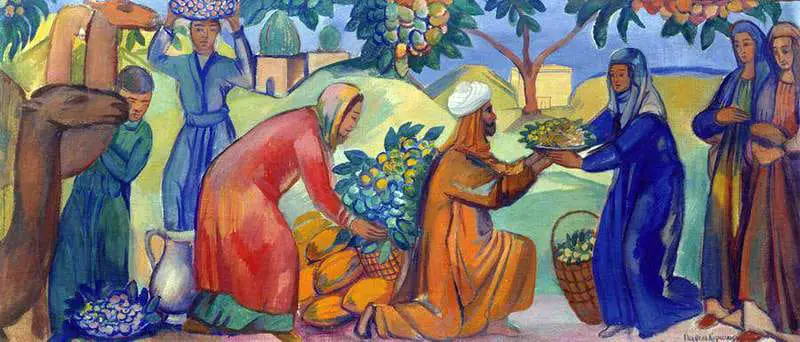The Blue Rose artists represented the second wave of Symbolist painting in 20th century Russia. They followed on the heels of the World of Art, but the two groups differed in many stylistic and philosophical ways. The Blue Rose group was more strongly influenced by the French Symbolist painters and the Russian Symbolist writers, specifically Belyi, Aleksandr Blok, Valerii Bryusov, Vyacheslav Ivanov and Soloviev.
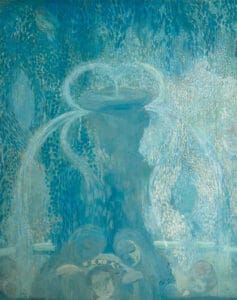
They used movement and fluidity as strong elements of their art. They also played with reduced, often non-figurative images. It was their intention to capture and promote transcendence through the medium of art and they used a combination of visual motifs towards this end. In particular they were obsessed with the Woman as an artistic concept.
The atmosphere and décor of the Blue Rose Exhibition of 1907 – the only time all sixteen of the recognized artists showed their work together – was in keeping with this intent. The set-up was almost fragile and ethereal, in direct contrast with the social upheaval outside. The result was a transcendent atmosphere – suggestive of that ulterior reality behind the surface of the paint. Art critic Sergei Makovsky described the exhibition as follows:
“[The artists] are in love with the music of color and line. They have heralded that primitivism to which modern painting has come in its search for a rebirth at its very sources – in spontaneous creation unweakened by the weight of historical experience.” (Moscow 213)
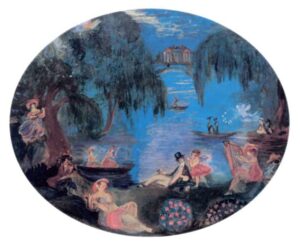
The event ran from March to April and was financed by Nikolai Riabushinsky, patron of the arts and editor of Zolotoe Runo. By 1907, most of the group had actually worked very closely together for nearly a decade. By 1900 most were already enrolled together at the Moscow Institute of Painting, Sculpture and Architecture. This group of artists included Anatolii Arapov, Nikolai and Vasilii Milioti, Feofilaktov, Pavel Kuznetsov, Nikolai Sapunov, Martiros Saryan, the sculptor Aleksandr Matveev, Sergei Sudeikin and Petr Utkin. Another important starting place for the group was in Saratov, where Sudeikin and Utkin studied under Viktor Borisov-Musatov.
Since the Blue Rose artists tended to see their works as vehicles for transcendence, their style encouraged intuitive understandings rather than intellectual inquiry and social consciousness. Concrete objects got reduced to their marrow and the artists utilized a lot of non-figurative imagery. They were intentionally unconcerned with contrast or delineation. Since the point was, for them, the intuitive feelings summoned by the piece rather than the conscious intellectual associations, they likewise dismissed the idea of superimposed symbolic meaning. This showed perhaps especially in their choice regarding color. The Blue Rose artists tended to ignore color schemes all together – creating instead dreamy, unending moonscapes of blues, greens and greys.
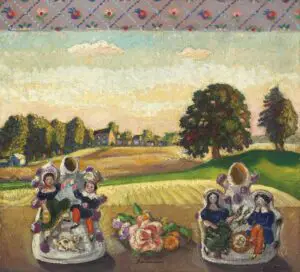
The Blue Rose artists wished to strike at the heart of expression in order to communicate with the public on an intuitive level. In order to connect to the fundamentals of time and reality, the artists incorporated the qualities of music and movement into their pieces – primarily by the employment of curves and circles. Looking back, the paintings of the Blue Rose artists, with their emphatically-curved renderings and their focus on the color blue, conformed very well with Kandinsky’s conclusions about painted movement. According to Kandinsky, “blue develops a centrifugal movement (like a snail retreating into its shell) and moves away form you.” Adding to this the lack of delineation and the tendency to minimize objects, the Blue Rose pieces tend to possess an undulating quality. Some examples of this are Kuznetsov’s “Morning of Love” and Sudeikin’s “Moonlit Eros.”
The purpose of all of this was, of course transcendence. This is one way these artists differed from the artists in the World of Art. The others, in contrast, embraced stylization, color, movement and delineation for the sake of aesthetics only. The World of Art looked to a reprisal of past glories and truths while the Blue Rose artists sought to connect to the “other shore.”
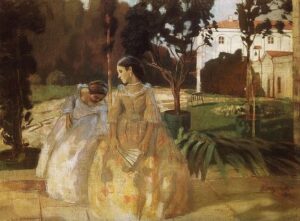
The Blue Rose artists were influenced by trends in French Symbolism and by the dominant motifs of Russian Symbolist authors. Both influences can be seen clearly in the attention paid to the Woman as a conduit for transcendence. Belyi, Blok and Soloviev wrote about the eternal feminine. Soloviev in particular believed that sex could serve as a pathway to harmony and the Absolute. Meanwhile, French artists Denis and Gauguin often focused on the innate artistic value of the female form. There were, however, other common motifs utilized for a similar purpose by the Russian writers and Blue Rose painters alike, including babies, fountains and rainbows.
Within the Blue Rose society, the Woman as a subject yielded many divergent avenues of thought. For Borisov-Musatov, the Woman was depicted as part peaceful and maternal and part phantasmal. The latter can be seen in his works Gobelin (1901) and Reservoir (1902). These works were also on a monumental scale – making the subjects appear even more powerful and eternal.
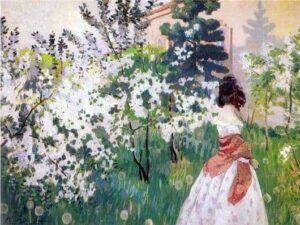
The spiritualism which has been so frequent a theme in Russian art found a profound outlet in the Blue Rose’s transcendent aspirations, but not everything ended in babies and rainbows. Instead, a sense of dread began to pervade the mystically-themed works of the Blue Rose’s leader, Kuznetsov. Early on, he had painted on the assumption that maternity and pregnancy were the embodiment of all higher truth. Following a subsequent disillusionment with this philosophy, he began depicting frustrated hopes and a vague sense of imminent tragedy. He painted fountains, arches, female heads, embryos and wispy foliage. Some of his main works were Birth, Morning and White Fountain. Sudeikin, too, evoked a sense of death, love and pain in his ethereal depictions of women. At some point, for both Sudeikin and Kuznetsov, the pictures meant to link humanity to the truth of existence, darkened.
Following the Blue Rose exhibition, Kuznetsov went into a decadent period (1907-1909), during which he painted Night of the Consumptives.
Source Material From:
Russian Art Gallery, The University of Southern California
Moscow & St. Petersburg 1900-1920: Art, Life & Culture of the Russian Silver Age, “Flowers, Flowers to Cover the Tomb! Blooms of Decadence,” by John E. Bowlt. The Vendome Press, 2008.
“The Blue Rose: Russian Symbolism in Art” by John E. Bowlt in The Burlington Magazine, August 1976.


